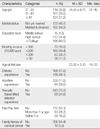Abstract
Purpose
This study was conducted to examine the factors associated with HPV (Human Papillomavirus) related stigma, shame and intent to have HPV test among adult women.
Methods
Data were collected from December 1, 2009 to January 31, 2010, and participants were 324 women who visited an obstetric gynecologic clinic. They anticipated testing positive for HPV. Then HPV related stigma, shame, intent to have HPV testing and HPV knowledge were measured. Descriptive statistics, Mann-Whitney U test, Kruskal Wallis test and multivariate adjusted logistic regression were used for data analysis.
Results
The levels of stigma and shame were higher than average. Intent to have HPV test was high and HPV knowledge was low. Women who answered that HPV is not sexually transmitted had lower HPV stigma than did women who answered they didn't know (OR=0.20, 95%CI 0.06-0.68). Women with lower stigma showed lower intent to have HPV test than women with higher stigma (OR=0.46, 95%CI 0.26-0.82).
Figures and Tables
References
1. Cervical cancer screening guidelines. American Cancer Society. 2002. 11. Retrieved August, 6, 2011. from http://www.cdc.gov/std/hpv/ScreeningTables.pdf.
2. Cunningham S.D., Tschann J., Gurvey J.E., Fortenberry J.D., Ellen J.M. Attitude about sexual disclosure and perceptions of stigma and shame. Sexually Transmitted Infections. 2002. 78:334–338. http://dx.doi.org/10.1136/sti.78.5.334.
3. Goldsmith M.R., Bankhead C.R., Kehoe S.T., Marsh G., Austoker J. Information and cervical screening: A qualitative study of women's awareness, understanding and information needs about HPV. Journal of Medical Screening. 2007. 14:29–33. http://dx.doi.org/10.1258/096914107780154459.
4. Kim H.W., Ahn H.Y. Study on the knowledge of Human Papillomavirus in female university students. Korean Journal of Women Health Nursing. 2007. 13:13–20.
5. Kim S.H., Lee K.Y., Park T.J., Kim J.S., O H.S. Factors related to Human Papillomavirus infection rate in women. Korean Journal of Family Medicine. 2009. 30:972–978. http://dx.doi.org/10.4082/kjfm.2009.30.12.972.
6. Kim Y.T. Current status of cervical cancer and HPV infection in Korea. Journal of Gynecologic Oncology. 2009. 20:1–7. http://dx.doi.org/10.3802/jgo.2009.20.1.1.
7. Lichtenstein B. Stigma as a barrier to treatment of sexually transmitted infection in the American deep south: Issues of race, gender and poverty. Social Science and Medicine. 2003. 57:2435–2445. http://dx.doi.org/10.1016/j.socscimed.2003.08.002.
8. Maggino T., Casadei D., Panontin E., Fadda E., Zampieri M.C., Dona M.A., et al. Impact of an HPV diagnosis on the quality of life in young women. Gynecologic Oncology. 2007. 107:S175–S179. http://dx.doi.org/10.1016/j.ygyno.2007.07.013.
9. Malta M., Bastos F.I., Strathdee S.A., Cunningham S.D., Pilotto J.H., Kerrigan D. Knowledge, perceived stigma, and care-seeking experiences for sexually transmitted infections: A qualitative study from the perspective of public clinic attendees in Rio de Janeiro, Brazil. BMC Public Health. 2007. 7:18. http://dx.doi.org/10.1186/1471-2458-7-18.
10. Marlow L.A.V., Waller J., Wardle J. Sociodemographic predictors of HPV testing and vaccination acceptability: Results from a population representative sample of British women. Journal of Medical Screening. 2008. 15:91–96. http://dx.doi.org/10.1258/jms.2008.008011.
11. McCaffery K., Forrest S., Waller J., Desai M., Szarewski A., Wardle J. Attitudes towards HPV testing: A qualitative study of beliefs among Indian, Pakistani, African-Caribbean and white British women in the UK. British Journal of Cancer. 2003. 88:42–46. http://dx.doi.org/10.1038/sj.bjc.6600686.
12. McCaffery K., Irwig L. Australian women's needs and preferences for information about human papillomavirus in cervical screening. Journal of Medical Screening. 2005. 12:134–141. http://dx.doi.org/10.1258/0969141054855238.
13. McCaffery K., Waller J., Forrest S., Cadman L., Szarewski A., Wardle J. Testing positive for human papillomavirus in routine cervical screening: Examination of psychosocial impact. British journal of obstetrics and gynaecology. 2004. 111:1437–1443. http://dx.doi.org/10.1111/j.1471-0528.2004.00279.x.
14. McCaffery K., Waller J., Nazroo J., Wardle J. Social and psychological impact of HPV testing in cervical screening: A qualitative study. Sexually Transmitted Infections. 2006. 82:169–174. http://dx.doi.org/10.1136/sti.2005.016436.
15. Rusch M., Shoveller J., Burgess S., Stancer K., Patrick D., Tyndall M. Association of sexually transmitted disease-related stigma with sexual health care among women attending a community clinic program. Sexually Transmitted Diseases. 2008. 35:553–557. http://dx.doi.org/10.1097/OLQ.0b013e3181685855.
16. Waller J., Marlow L.A.V., Wardle J. The association between knowledge of HPV and feelings of stigma, shame and anxiety. Sexually Transmitted Infections. 2007. 83:155–159. http://dx.doi.org/10.1136/sti.2006.023333.
17. Waller J., McCaffery K., Forrest S., Szarewski A., Cadman L., Wardle J. Awareness of human papillomavirus among women attending a well woman clinic. Sexually Transmitted Infections. 2003. 79:320–322. http://dx.doi.org/10.1136/sti.79.4.320.




 PDF
PDF ePub
ePub Citation
Citation Print
Print







 XML Download
XML Download